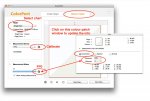marc3llo
Well-known member
Hello everybody,
I have a problem with measuring pantone colours. I have a customer who is measuring delta E (against the pantone digital library) with a spectroeye xrga and I am trying to read the same colours with the eyeone. Is there any chance that we'll succeeded? I have the eyeone connected to esko color engine and I can set up the correct ansi, d50 and delta formula 2000 but I can't find the way to change the observers angle and whether the white is absolute or not.
Do you know a way to measure similar or approximate values with the Eyeone compared to those read by the spectroeye xrga?
Thanks for your help!
Marcelo
I have a problem with measuring pantone colours. I have a customer who is measuring delta E (against the pantone digital library) with a spectroeye xrga and I am trying to read the same colours with the eyeone. Is there any chance that we'll succeeded? I have the eyeone connected to esko color engine and I can set up the correct ansi, d50 and delta formula 2000 but I can't find the way to change the observers angle and whether the white is absolute or not.
Do you know a way to measure similar or approximate values with the Eyeone compared to those read by the spectroeye xrga?
Thanks for your help!
Marcelo














